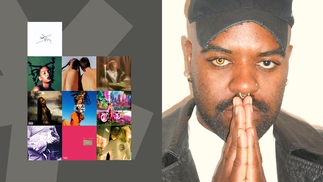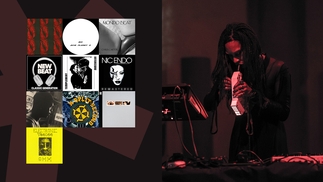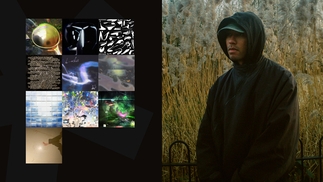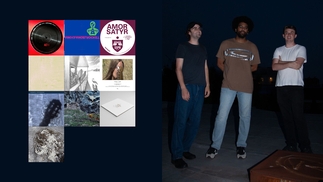Aïsha Devi is using frequency and spirituality to heal our bodies and free our minds

Houndstooth mainstay Aïsha Devi has caused shock and awe with her wild live shows and mind-boggling releases. Yet, as DJ Mag discovers, her experiments with sound are designed with a positive purpose, bringing together science and spirituality to start a healing revolution of frequency...
Aïsha Devi’s stare burns onto her machines with the intensity of a laser. To her back, left and right, a flickering, kaleidoscopic series of visuals and lights looms above the packed space of Oslo, Hackney. A deafening sub-bass erupts across the room, hammering the ears, chest, teeth and hair of everyone it crosses, burrowing deep into bodies as two more frequencies, higher pitched now, weave like serpents into the vibrating mix. Devi moves forward, standing solitary above a crowd of transfixed followers. She raises her microphone, breathes in, and unleashes a howl.
For the next hour, the Geneva-based artist uses her hardware set-up and unflinching voice to veer from deconstructed, ethereal trance to enveloping noise and punishing rave-inspired beats, crafting an experience that is at once cathartic and challenging, harrowing and invigorating. Without pause, she courses through cuts from her recent sophomore LP ‘DNA Feelings’ and her 2015 debut ‘Of Matter and Spirit’ — both released on Houndstooth — as well as numerous experimental sounds that live exclusively in her live set. Once finished, the crowd slowly shakes free from her spell and she smiles, walks again to the front of the stage and says, “Thank you for letting us elevate together”.
“You can heal yourself with frequency,” she tells DJ Mag the following day, sat outside Dalston’s Café OTO in the blazing sun. “My goal is to make people understand that frequency is all around us but that it is really badly used. We are full of parasite frequencies that have untuned the whole earth. Your fridge is sending frequencies, your Mac, your telephone. There’s all this amazing technology in our hands but we are receiving the bad impact of it. It’s consciously used to control people. I think now it is time that we as artists, as humans, reclaim its power.”
It quickly becomes apparent when speaking to Aïsha Devi that her intention extends far beyond just making albums and playing gigs. For her, music is revolutionary, spiritual, political and scientific. Where those “parasite frequencies” surround and ensnare us, she wishes to infiltrate with frequencies of her own in order to liberate, awaken and elevate whoever will hear them. By using the right sounds, wound together like DNA, she believes we can alter our consciousness and be empowered, cured and freed, at least in part, from the burden of physical reality and its societal pains.
“We are overcome with music that hypnotises us on a very low level,” she explains. “Music is used in a subliminal way to make you into a perfect little consumer in society, to control and induce your desire in pop culture and in capitalism. I’m calling music to come back to ritual, to the healing aspect, to the opposite of what it is now.”

SPIRITUALITY
Boldly ambitious though it may seem, none of this is said with any trace of flippancy. Devi’s objectives have been forming for quite some time, with an ever-expanding determination. About eight years ago, a period of self-doubt and despondency lead to her abandoning her critically hyped Kate Wax moniker in pursuit of personal rediscovery. She started making music under her own name and launched the experimental collective and label, Danse Noire, which now thrives in the Genevan underground, releasing music from acts like Réelle, Meuko! Meuko! and and Abyss X. In that time, Devi also began to research her paternal Nepalese-Tibetan ancestry, discovering Eastern spirituality and ancient Hindu texts called The Vedas, as well as learning about psychology, physics, Hermetics, pre-Christian metaphysics and mysticism. Most importantly, however, in that time she started to meditate, a practice which, with the aid of vocal vibrations, healed her from “so many crazy things”, she says now.
What she found through all these studies, from the intuitive sciences through to the mysticism and ritual, was that each practice treated sound, tone and frequency with the same monumental degree of importance. From the spiritual, vocalised “Om” of ancient Hinduism used in meditation, to the experiments with binaural beats used in physics, frequency’s power and potential was absolutely crucial in understanding and reclaiming human consciousness in order to free it. To separate mind from body, matter from non-matter.
As a voice tells us on ‘DNA Feelings’ track ‘Time (Tool)’, “Ego sees the visible spectrum only, but the conscious mind embraces infinite space and eternity.”
“The frequencies I’m working with have a particular difference between the right and left ear,” Devi explains. “This induces relaxation and a state of supra consciousness. There have been studies where people were introduced to these types of frequencies and and it’s had the exact same effect as if they were under a drug. It’s why people love drugs, because they can escape their physicality. I think music has the same ability.”
These discoveries culminated in the release of the frenetic, feverish and transfixing ‘Of Matter and Spirit’ LP in 2015. The album found Devi utilising intricate modern technologies coupled with vocal techniques as ancient as they come as a way of defying contemporary music’s “sterile” frequencies and restrictive formulas. In doing so, she sought to alter people’s perception of physical reality. Tracks like the haunting, wordlessly sung ‘O.M.A.’ and the incendiary ‘Numen J’ were transportative, hypnotic demonstrations of an artist reborn and determined. As she explains, the goal was, and continues to be, the subversion of pop music’s immediately gratifying closed harmonies in exchange for liberated frequency.
“The idea,” she says. “Is to hijack entertainment.”
Coupled with the immersive video game released in tandem with her debut and the ever expanding visual component of her live show — courtesy of graphic artist Emile Barret — her attempts to do just that are constantly progressing.
“At some point the intention is to transcend physicality,” she remarks. “To make people feel like they are not belonging to the 3D anymore. To make you lose your consciousness about what’s on the floor, what’s up there, where are your feet, where are your arms.
“We are trapped in hyper-materialism,” she adds. “What I like about virtual reality and video games is that we’re making people slightly and slowly understand that everything can only be information, everything can only be frequency. I love video games because they show people that your brain, your intention and your being can exist in that virtual world. “I think capitalism is all about suffering and trying to heal that suffering with money. Filling the void. I want to show that there’s actually no void to fill.
“Pop music knows how to make you feel self-satisfied,” she says. Satisfied maybe, but not nourished.
"I am tuning into the healing frequency. I want to empower people to understand that they are actors in their own wellbeing"
AWAKENING
Devi’s introduction in art school to the types of electronic music she looks up to was “magic”, she says, and discovering acts like Aphex Twin, Autechre and Pan Sonic was an awakening in and of itself. Given the creative freedom and purpose she felt when she started to make music in her bedroom, long before Kate Wax even, it is perhaps no surprise that her magisterial control over those tools has evolved in the way it has.
“I had ideas in my head and my computer was exactly extending them,” she remembers. “There was no in-between. It was autonomy, just being totally free with my own context, whenever I wanted. It's very close to a meditative state. I love working with machines because I know exactly which frequency I’m sending to people. It’s energetic. It’s spiritual.
“It was the same in the ‘90s in the trance world,” she continues. “They were using the same frequencies. I’m using the same Jupiter-80 synthesiser that can tune two frequencies at once so it sounds exactly like a binaural. It has a modifying effect on people’s consciousness. Of course it was used to hypnotise people, but my intention isn’t to hypnotise. I am tuning into the healing frequency. I want to empower people to understand that they are actors of their own wellbeing.”
And that trance energy is found throughout both of her records, not only in the soaring vocals but also in the pulverising rhythms — a nod perhaps, to both the elevating, meditative quality of communal drum circles and also the contemporary collective escapism of the rave.
“I love raving because the intention was always there to gather,” she says. “To dance and transcend with music in a forest or somewhere. It was a way of meditating together.”

Where ‘Of Matter and Spirit’ felt like an eruptive epiphany, 2018’s ‘DNA Feelings’ feels more refined, its purpose more definite. Over its 11 tracks the musical intention is much the same as before, but this time the presence of her electronic forebears is embellished by a bolder influence from her idol, renowned indian sitarist Ravi Shankar, whose treatment of multi-tonality and frequency was deeply spiritual, innate and transcendent.
“He is just a huge inspiration for me,” she beams. “When Ravi Shankar used to tune his sitar he would meditate for one hour then he would send an Om with his voice and would tune the sitar from that!”
Breathtaking altered vocals and shimmering electronics cascade through ‘Intentional Dreams’ while supercharged rave stabs give ‘Inner State Of Alchemy’ a fervent purpose. This time, however, Devi appears more assertive in her mission of shattering pop and contemporary music’s restrictive form and freeing listeners from the parasite frequencies that she believes are used by capitalist society to force us into consumption. That voice — which is not her own — which appears on ‘Time (Tool)’ and again in ‘Time Is The Illusion of Solidity’ serves almost as an invitation, a presentation of potential for all of us to expand our consciousness and perception.
Crucially, Aïsha Devi’s purpose is to gather a global community, to share her message with as many people as possible and to inspire what she describes as a “frequencial revolution” rooted in togetherness. Her music, both live and on record, is a shared, mutually assisted experience.
“I’m not waiting for the audience to be totally submissive and only receive something,” she asserts. “The artist isn’t on top of a pyramid or something. I love the new era of musicians who have the ability of giving frequency to people. My intention in delivering music is to have a dialogue. My shows are better when I receive energy back from people. It’s a wave.”
It’s something that resonates in that simple message of mutual elevation shared the end of the previous night’s performance. It radiates from her ongoing underground pursuits with Danse Noire and in her linking up with like minded artists across the globe, from China to LA. Not only will she be touring her live show extensively in the coming year, she’s also starting to give lectures based on her frequencial studies, sharing her intention of expansive understanding in a format other than that of live music.
And so it seems that, almost a decade on from Aïsha Devi’s awakening, her story is unfolding rapidly and with ferocious intention. Above all, she wants to welcome you into that story, to help you feel the healing, liberating power of frequency, of music, of an open mind.
“It’s like a good movie,” she concludes. “You can see it in many layers. If you are very down to earth, you can only talk about the physical part of it. But you can always go further... And that’s the premise of physics. We’re doing it with music.”
Photos: Emile Barret





